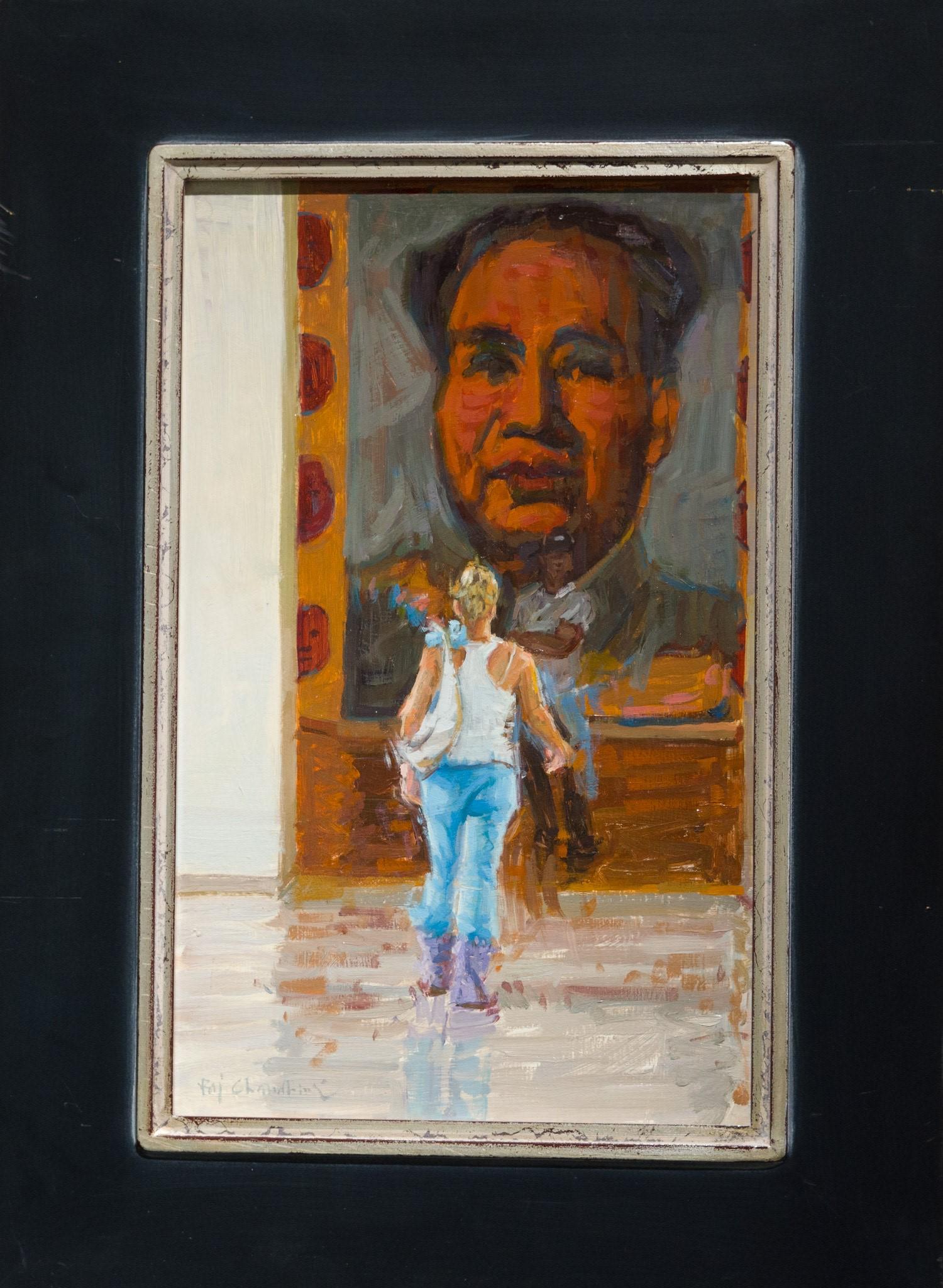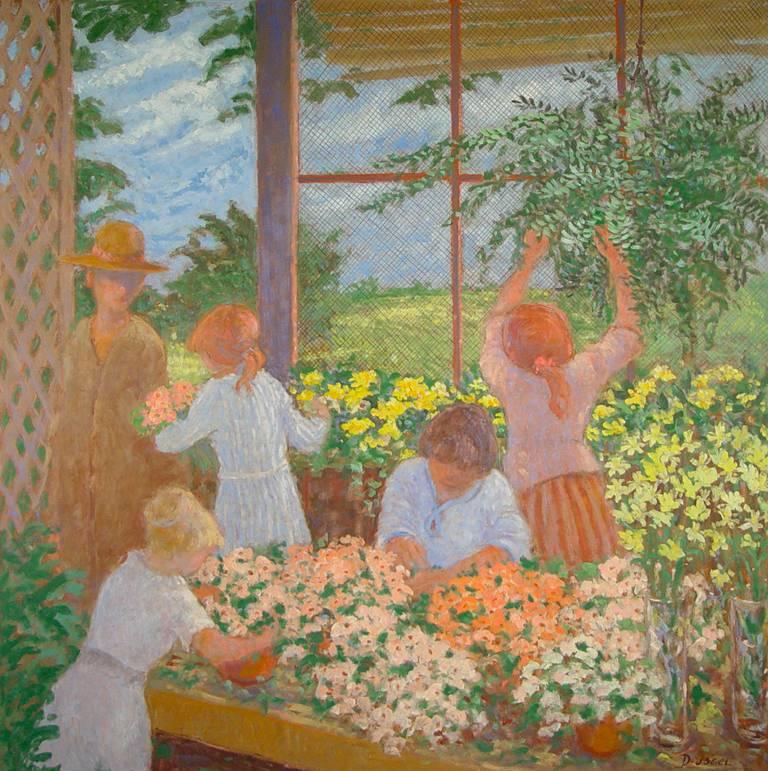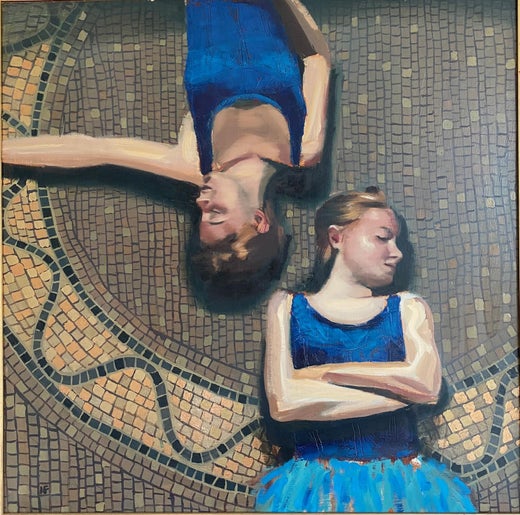Items Similar to "Dancers reading III", Impressionist Indoor scene with tow girls. Oil on panel .
Want more images or videos?
Request additional images or videos from the seller
1 of 13
Iain FAULKNER"Dancers reading III", Impressionist Indoor scene with tow girls. Oil on panel .
About the Item
"Dancers reading III", Impressionist Indoor scene with tow girls. Oil on panel.
Measurements in centimeters: 61 x 61 cm / In inches 24.02 x 24.02 “
Framed: 78 x 78 x 4 cm. / In inches 30.71 x 30.71 x 1.57 "
This artwork, signed IF by Scottish artist Iain Faulkner in the top right corner, is a very well studied composition with two dancers, dressed in blue color, lying on a beautiful mosaic floor with round border, reading leisurely, perhaps reviewing the libretto. The circle design of the mosaic, the figures in three quarters in parallel; opposite the postures; also the suits, the colors blue and flesh, and opposite the white scripts. This complementation above and below, and to the left and right of the painting, gives the painting a surprising composition and excellent balance.
Despite the thick brushwork, the author achieves a very subtle effect in the definition of the two beautiful figures and very successful effects of light and shadow.
Iain Faulkner acknowledges the influence on his painting of artists such as Sargent, Degas, Whistler and, especially, Vermeer, showing scenes with figures performing everyday tasks while lost in thought, like this two dancers.
This piece was originally purchased from Albemarle Gallery in London.
ABOUT THE ARTIST
Born in Glasgow in 1973 and graduating from Glasgow School of Art in 1996 with a BA (Honours) in Fine Art.
His degree show was sell-out.
Iain Faulkner is now one of Britain's top figurative painters, a stablished artist with the Albemarle/Pontone Galleries in London, and with numerous solo shows in New York, Paris, Geneva, Monaco and Bologna .
His work appears in many private and corporate collections and in the Scottish National Portrait Gallery.
In 2010 he was commissioned to paint the European Ryder Cup Team members portraits.
- Creator:Iain FAULKNER (Scottish, British)
- Dimensions:Height: 30.71 in (78 cm)Width: 30.71 in (78 cm)Depth: 1.58 in (4 cm)
- Medium:
- Movement & Style:
- Period:
- Condition:
- Gallery Location:Segovia, ES
- Reference Number:1stDibs: LU744310805612
Iain FAULKNER
Born in Glasgow in 1973 and graduating from Glasgow School of Art in 1996 with a BA (Honours) in Fine Art. is degree show was a sell-out. Iain Faulkner is now one of Britain's top figurative painters. An established artist with the Ablemarle/ Pontone Galleries in London and with numerous solo shows in New York, Paris, Geneva, Monaco and Bologna. His work appears in many private and corporate collections and in the Scottish National Portrait Gallery. In 2010 he was commissioned to paint the European Ryder Cup Team members portraits.
About the Seller
5.0
Vetted Seller
These experienced sellers undergo a comprehensive evaluation by our team of in-house experts.
Established in 2002
1stDibs seller since 2017
58 sales on 1stDibs
Typical response time: 4 hours
- ShippingRetrieving quote...Ships From: Trescasas, Spain
- Return PolicyA return for this item may be initiated within 14 days of delivery.
More From This SellerView All
- "Dancers resting VII". Impressionist interior scene with two girls. Oil on panelBy Iain FAULKNERLocated in Segovia, ES"Dancers resting VII". Impressionist interior scene with two girls. Oil on panel Measurements in centimeters: 61 x 61 cm / In inches 24.02 x 24.02 “ Framed: 78 x 78 x 4 cm. / In inches 30.71 x 30.71 x 1.57 " This artwork , signed IF in the left down corner, by the author Iain Faulkner, is a very well studied composition with two dancers, dressed in blue color, lying on a beautiful mosaic floor with gold border, having a rest. The circle design of the mosaic, the figures in three quarters in parallel; opposite the postures, the suits, and the colors blue and flesh. This complementation above and below, and to the left and right of the painting, gives the painting a surprising composition and excellent balance. Despite the thick brushwork, the author achieves a very subtle effect in the definition of the two beautiful figures and very successful effects of light and shadow. Iain Faulkner acknowledges the influence on his painting of artists such as Sargent, Degas, Whistler and, especially, Vermeer, showing scenes with figures performing everyday tasks while lost in thought, like this two dancers. This piece was originaly purchased from Albemarle Gallery in London. ABOUT THE ARTIST Born in Glasgow in 1973 and graduating from Glasgow School of Art in 1996 with a BA (Honours) in Fine Art. His degree show was sell-out. Iain Faulkner is now one of Britain's top figurative painters, a stablished artist with the Albemarle/Pontone Galleries in London, and with numerous solo shows in New York, Paris, Geneva, Monaco and Bologna . His work appears in many private and corporate collections and in the Scottish National Portrait Gallery. In 2010 he was commissioned to paint the European Ryder Cup...Category
Early 2000s Impressionist Figurative Paintings
MaterialsOil, Panel
- The window (La ventana) Folk Art. Green, blue, yellow, orange interior sceneBy Raquel FariñasLocated in Segovia, ESThe window (La ventana) . Folk Art, Acrylic on wood panel painting by Spanish author Raquel Fariñas. Dimensions in centimetres (H) 177,3 x (W) 95 x (D) 4 In inches: (H) 69.7 x (W)...Category
2010s Folk Art Figurative Paintings
MaterialsAcrylic, Wood Panel
- Series "The Imaginary traveler nº29" Expressionist corner with flowers and cat.By Chico MontillaLocated in Segovia, ESSeries "The Imaginary traveler nº29" Expressionist corner with flowers and cat. Oil on linen by Chico Montilla. Measurements: (H) 100 x (W) 81 x (D) 2 cm. Framed (H) 112 x (W) 93 ...Category
2010s Expressionist Figurative Paintings
MaterialsLinen, Oil
- Orquídea (Orchid)By Chico MontillaLocated in Segovia, ESExpressionist interior corner that has an orchid as its protagonist. Predominant chromaticism between fuchsia-pink and yellow. Oil on linen by Spanish artist Chico Montilla. Beautifu...Category
Early 2000s Expressionist Figurative Paintings
MaterialsLinen, Oil
- Christmas (La Navidad). Fun family scene around the Christmas tree.By Elena NarkevichLocated in Segovia, ESChristmas (La Navidad) acrylic paint on canvas by Elena Narkevich. Dimension not framed: 195 H x 162 W cm x 2 cm D In inches: 76.77 H, 63.78 W, x 1.18 D Elena Narkevich work is well...Category
Early 2000s Contemporary Figurative Paintings
MaterialsAcrylic, Canvas
- Rainy day. Oil on canvas. Impressionistic colorful street scene.By Vladimir AndreevLocated in Segovia, ESRainy day. Oil on canvas by Vladimir Andreev. Impressionistic street scene. Dimension art: 50 x 40 cm. Framed: 59 x 49 x 3,5 cm In inches: 19.70 x 15.75 in. Framed: 23.23 x 19.3 0 x 1.38 in. Signed "Andreev" in the down left corner, inscribed in Cyrillic verso. A bright rainy day in a big city. The tall towers can be seen at the end of the busy avenue and the colorful coats...Category
Late 20th Century Impressionist Figurative Paintings
MaterialsCotton Canvas, Oil
You May Also Like
- Mother and Daughter Arranging Daffodils in a Vase - Oil on CanvasLocated in Soquel, CAMother and Daughter Arranging Daffodils in a Vase - Oil on Canvas Charming depiction of a mother and daughter with daffodils by Lois Amelia Budlong-Phillips (American, 1857-1932). A...Category
Early 20th Century American Impressionist Figurative Paintings
MaterialsCanvas, Oil, Wood Panel
- Old Men with Kittens - Impressionist Oil, Figures in Interior by J F RaffaelliBy Jean-Francois RaffaelliLocated in Marlow, BuckinghamshireA wonderful oil on panel by French impressionist painter Jean-Francois Raffaelli depicting two old men seated in an interior. One is reading his paper as the other naps and there are several kittens on the floor. Painted in the artist's distinctive style. The work is accompanied by a certificate from Brame & Lorenceau and is included in the catalogue raisonne of the painter. Signature: Signed lower left Dimensions: Framed: 9.5"x8" Unframed: 5.5"x4" Provenance: Private collection - United States Original artists label verso Jean-François Raffaëlli's father was a failed Italian businessman and Raffaëlli himself was, among other things, a church chorister, actor and theatre singer. He then studied under Gérôme at the École des Beaux-Arts in Paris. He travelled to Italy, Spain and Algeria and on his return to France settled in Asnières. In 1876, on a trip to Brittany, he first saw the potential of realist subject matter, if treated seriously. He became involved in meetings of artists at the Café Guerbois, where the Impressionist painters used to gather. As a result, Degas, contrary to the advice of the group, introduced Raffaëlli to the Impressionist exhibitions - according to one uncertain source as early as the very first exhibition, at the home of Nadar, and certainly to those of 1880 and 1881. In 1904, Raffaëlli founded the Society for Original Colour Engraving. He first exhibited at the Salon de Paris in 1870 and continued to exhibit there until he joined the Salon des Artistes Français in 1881, where he earned a commendation in 1885, was made Chevalier of the Légion d'Honneur in 1889 and in the same year was awarded a gold medal at the Exposition Universelle. In 1906 he was made Officier of the Légion d'Honneur. He was also a member of the Société Nationale des Beaux-Arts. In 1884, a private exhibition of his work cemented his reputation. He contributed to several newspapers such as The Black Cat (Le Chat Noir) in 1885 and The French Mail (Le Courrier Français) in 1886 and 1887. He published a collection entitled Parisian Characters, which captured his favourite themes of the street, the neighbourhood and local people going about their lives. In 1880 he participated, with Forain, on the illustration of Joris Karl Huysmans' Parisian Sketches (Croquis Parisiens). He also illustrated Huysman's Works. As well as working as an illustrator, he also made etchings and coloured dry-points. His early attempts at painting were genre scenes, but once he was settled in Asnières he started to paint picturesque views of Parisian suburbs. From 1879 onwards, his subject matter drew on the lives of local people. These popular themes, which he treated with humanity and a social conscience, brought him to the attention of the social realist writers of the time such as Émile Zola. In addition to his realist style, Raffaëlli's dark palette, which ran contrary to the Impressionist aesthethic, helped to explain the opposition of those painters to his participation in their exhibitions. More concerned with drawing than colour, he used black and white for most of his paintings. Towards the end of his life, he lightened his palette, but without adopting any other principles of the Impressionist technique. After painting several portraits, including Edmond de Goncourt and Georges Clémenceau, he returned to genre painting, particularly scenes of bourgeois life. Later in his career, he painted mainly Breton-inspired sailors and views of Venice. His views of the Paris slums and the fortifications, sites which have almost completely disappeared, went some way towards establishing a genre in themselves and perpetuated the memory of the area: The Slums, Rag-and-Bone Man, Vagabond, Sandpit, In St-Denis, Area of Fortifications. His realistic and witty portrayal of typical Parisian townscapes accounts for his enduring appeal. Born in Paris, he was of Tuscan descent through his paternal grandparents. He showed an interest in music and theatre before becoming a painter in 1870. One of his landscape paintings was accepted for exhibition at the Salon in that same year. In October 1871 he began three months of study under Jean-Léon Gérôme at the École des Beaux-Arts in Paris; he had no other formal training. Raffaëlli produced primarily costume pictures until 1876, when he began to depict the people of his time—particularly peasants, workers, and ragpickers seen in the suburbs of Paris—in a realistic style. His new work was championed by influential critics such as J.-K. Huysmans, as well as by Edgar Degas. The ragpicker became for Raffaëlli a symbol of the alienation of the individual in modern society. Art historian Barbara S. Fields has written of Raffaëlli's interest in the positivist philosophy of Hippolyte-Adolphe Taine, which led him to articulate a theory of realism that he christened caractérisme. He hoped to set himself apart from those unthinking, so-called realist artists whose art provided the viewer with only a literal depiction of nature. His careful observation of man in his milieu paralleled the anti-aesthetic, anti-romantic approach of the literary Naturalists, such as Zola and Huysmans. Degas invited Raffaëlli to participate in the Impressionist exhibitions of 1880 and 1881, an action that bitterly divided the group; not only was Raffaëlli not an Impressionist, but he threatened to dominate the 1880 exhibition with his outsized display of 37 works. Monet, resentful of Degas's insistence on expanding the Impressionist exhibitions by including several realists, chose not to exhibit, complaining, "The little chapel has become a commonplace school which opens its doors to the first dauber to come along."An example of Raffaëlli's work from this period is Les buveurs d'absinthe (1881, in the California Palace of Legion of Honor Art Museum in San Francisco). Originally titled Les déclassés, the painting was widely praised at the 1881 exhibit. After winning the Légion d'honneur in 1889, Raffaëlli shifted his attention from the suburbs of Paris to city itself, and the street scenes that resulted were well received by the public and the critics. He made a number of sculptures, but these are known today only through photographs.[2] His work was also part of the painting event in the art competition at the 1912 Summer Olympics. In the later years of his life, he concentrated on color printmaking. Raffaëlli died in Paris on February 11, 1924 Museum and Gallery Holdings: Béziers: Peasants Going to Town Bordeaux: Bohemians at a Café Boston: Notre-Dame; Return from the Market Brussels: Chevet of Notre-Dame; pastel Bucharest (Muz. National de Arta al României): Market at Antibes; Pied-à-terre Copenhagen: Fishermen on the Beach Douai: Return from the Market; Blacksmiths Liège: Absinthe Drinker...Category
1890s Impressionist Figurative Paintings
MaterialsPanel, Oil
- Looking for Andy Oil on Panel 16" x 10" Framed New Orientalism ArtistLocated in Houston, TXSearching for Andy (Warhol) references woman looking at one of the 199 paintings that Andy Warhol did of Mao. This painting is usually seen in the museum exhibitions around the world Looking for Andy (Warhol) is 16" x 10" and is framed which makes it 20 " x 14" . The artist describes himself as one of the New Orientalists which is a traveling painter in the modern world. Raj Chaudhuri (b 1967) My work comes from my life as a human being. I paint what I know and love. Capturing people and their interaction with the environment interests me—be it urban or rural, cityscape or landscape. I strive to find beauty in everyday happenings and how we experience this amazing world in which we live. Growing up in India, I feel my work is enriched by the depth of culture, vibrant colors and energy there. Twenty-three years ago, Colorado became home, giving me a longstanding enjoyment of the mountains, the brilliance of people here and the rich history of the west. I truly enjoy traveling and painting on location; I thrive in painting subjects with which I have a deep connection and understanding of people, structures and landscape. Art has always been my passion. I found ways to incorporate my artistic abilities in UI design and software development before coming to art full time. To a great extent I find that what like in computer design and now in art is that we are creating abstractions of the real world. There are repeating patterns in how we solve problems in many arenas. The creation of a painting is a technical and visionary problem, with many aspects behind the brushstrokes and values. These challenges underlie the thrill of creating a piece that speaks to viewers, to see what we feel and know about the world around us in art. To me painting is about finding beauty, balance and something visually engaging. I am fascinated by how light illuminates my compositions. It is different literally in every painting! The design of a painting to me is paramount, and I try and find something beautiful, simple and clear in the composition and then build in layers upon layers of complexity. I want to lead the viewer through a visual journey and have them stay connected to the painting. Art is a way of expressing something deeply personal along with the pure enjoyment of the visual. My goal is to find an interesting design clearly present in each painting, so the viewer sees the abstract visual dialogue that sets up the appealing story of the subject in the painting. 2024 Best of Show Presented by the Coors Western Art Advisory Committee (last image of horse in snow...Category
2010s American Impressionist Interior Paintings
MaterialsOil, Panel
- "Limelight" Interior Oil Painting of BarLocated in Denver, COMark Andrew Bailey's "Limelight" is an original, handmade oil painting that depicts an impressionistic interior setting of a restaurant or dining hall. About the Artist: Artist Mar...Category
2010s Impressionist Figurative Paintings
MaterialsOil, Panel
- Flower ShedBy Donald S. VogelLocated in Dallas, TXThe greenhouse became a favorite subject of Donald Vogel's in the 1980's. As Vogel reflected in the 1998 catalogue published for his traveling retrospective exhibition, "The greenhou...Category
Late 20th Century American Impressionist Figurative Paintings
MaterialsOil, Panel
- Storage ShedBy Donald S. VogelLocated in Dallas, TXThe greenhouse became a favorite subject of Donald Vogel's in the 1980's. As Vogel reflected in the 1998 catalogue published for his traveling retrospective exhibition, "The greenhou...Category
Late 20th Century American Impressionist Figurative Paintings
MaterialsPanel, Oil






